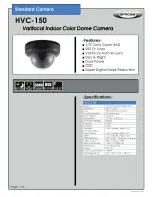
Alarm Box User Manual
2-6
Otherwise, lay the PVC cable tray along the wall to the floor, and then
lay the cables along the cable rack under the floor to the cabinet (down
cabling method where the cable tray may not be used in cabling under
the floor).
If the other ends of the cables need to be placed at the same place,
separate the cables in proper position. Moreover, put them into narrow
PVC cable trays, and lay them along the wall or along the cable racks
under the floor to the proper positions.
5. Put the power cables and the network cable into a bigger PVC cable tray.
After cabling is complete, close the top cover of the PVC cable tray.
Caution:
It may be unable to hide the AC adaptor somewhere. However, you can put it in
a safe place in the project site.
2.4 Connecting Cables (DC Power Cable and Network Cable)
Purpose
The alarm box can be connected to the DC power supply available by using
the 3-meter-long DC power cable delivered with the alarm box or a self-made
cable. The parameters of the self-made cable should comply with or be higher
than those of the delivered cable, as shown in Table 2.4-1.
Table 2.4-1 DC Power Cable Parameters
Parameter Value Parameter Value
Nominal
cross-sectional area
1mm
2
Jacket
thickness
0.87mm
Outer diameter
1.3mm
Outer diameter of
the jacket
6.94mm
Isolation thickness
0.65mm
Rated voltage
300/500V
Outer insulation
diameter
2.6mm
Critical
temperature
70
℃
The maximum DC
resistance at 20
℃
20
Ω
/km N/A
N/A
















































